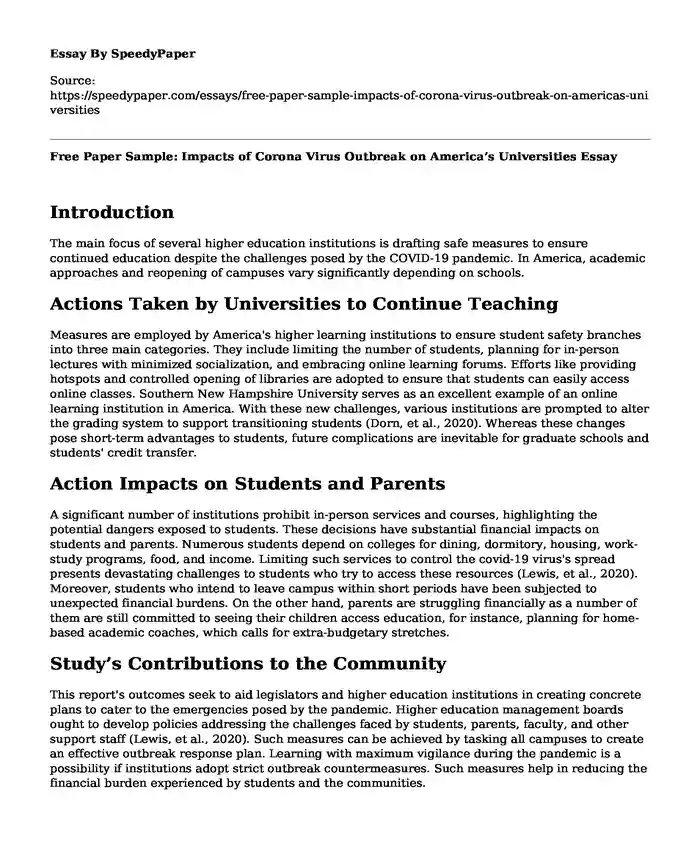
| Type of paper: | Essay |
| Categories: | University United States Covid 19 |
| Pages: | 3 |
| Wordcount: | 656 words |
Introduction
The main focus of several higher education institutions is drafting safe measures to ensure continued education despite the challenges posed by the COVID-19 pandemic. In America, academic approaches and reopening of campuses vary significantly depending on schools.
Actions Taken by Universities to Continue Teaching
Measures are employed by America's higher learning institutions to ensure student safety branches into three main categories. They include limiting the number of students, planning for in-person lectures with minimized socialization, and embracing online learning forums. Efforts like providing hotspots and controlled opening of libraries are adopted to ensure that students can easily access online classes. Southern New Hampshire University serves as an excellent example of an online learning institution in America. With these new challenges, various institutions are prompted to alter the grading system to support transitioning students (Dorn, et al., 2020). Whereas these changes pose short-term advantages to students, future complications are inevitable for graduate schools and students' credit transfer.
Action Impacts on Students and Parents
A significant number of institutions prohibit in-person services and courses, highlighting the potential dangers exposed to students. These decisions have substantial financial impacts on students and parents. Numerous students depend on colleges for dining, dormitory, housing, work-study programs, food, and income. Limiting such services to control the covid-19 virus's spread presents devastating challenges to students who try to access these resources (Lewis, et al., 2020). Moreover, students who intend to leave campus within short periods have been subjected to unexpected financial burdens. On the other hand, parents are struggling financially as a number of them are still committed to seeing their children access education, for instance, planning for home-based academic coaches, which calls for extra-budgetary stretches.
Study’s Contributions to the Community
This report's outcomes seek to aid legislators and higher education institutions in creating concrete plans to cater to the emergencies posed by the pandemic. Higher education management boards ought to develop policies addressing the challenges faced by students, parents, faculty, and other support staff (Lewis, et al., 2020). Such measures can be achieved by tasking all campuses to create an effective outbreak response plan. Learning with maximum vigilance during the pandemic is a possibility if institutions adopt strict outbreak countermeasures. Such measures help in reducing the financial burden experienced by students and the communities.
Why Interested in this Topic
The topic has significant importance since, during an economic downturn, social safety measures shift to help families with difficulties. Low-income campus students usually stand minimal chances of getting such aid. Since several students access family properties, most social safety programs implement additional requirements to impair students' chances of qualifying for such programs during a pandemic. For instance, the idea of students who are eligible for food stamps had to meet some requirements like acquiring Federal work-study or working for at least twenty hours a week (Dorn, et al., 2020). Medicaid and unemployment eligibility vary differently across the American states, and in most cases, presents an enormous financial burden to students.
Problem Statement
Finally, the origin of the COVID-19 virus has been traced back to seafood from Wuhan, China. Medical experts are yet to establish the actual animal species associated with the virus. The most common symptoms range from fatigue, cough, fever, headache, diarrhea, dyspnea, and hemoptysis to pneumonia. Various preventive measures like social distancing, washing hands regularly, wearing face masks, case detection, quarantine, and contact tracing help reduce its spread. Currently, no vaccine or cure has been proven by the scientific community. Therefore, confirmed patients depend heavily on supportive care and symptomatic treatments. COVID-19 susceptibility is mainly associated with biological sex, age, and the general state of a patient's health.
References
Dorn, E., Hancock, B., Sarakatsannis, J., & Viruleg, E. (2020). COVID-19 and student learning in the United States: The hurt could last a lifetime. McKinsey & Company.
Lewis, C. T., Zeineddine, H. A., & Esquenazi, Y. (2020). Challenges of Neurosurgery Education During the Coronavirus Disease 2019 (COVID-19) Pandemic: A US Perspective. World neurosurgery, 138, 545-547.
Cite this page
Free Paper Sample: Impacts of Corona Virus Outbreak on America's Universities. (2023, Dec 03). Retrieved from https://speedypaper.net/essays/free-paper-sample-impacts-of-corona-virus-outbreak-on-americas-universities
Request Removal
If you are the original author of this essay and no longer wish to have it published on the SpeedyPaper website, please click below to request its removal:
- Free Essay on the Failure of Barack Obama's Presidency
- Essay Example on Minnesota Law
- Free Essay on Gender and Patient in Providing Communication in Health Care
- Angela's Story: A Case Study on the Reproductive System. Essay Example
- Peptic Ulcers Disease - Free Paper Sample
- Research Proposal Example - Examining Anxiety
- Occupation's Therapeutic Tapestry: Impact on Health and Well-being in Contemporary Perspectives - Paper Example
Popular categories




